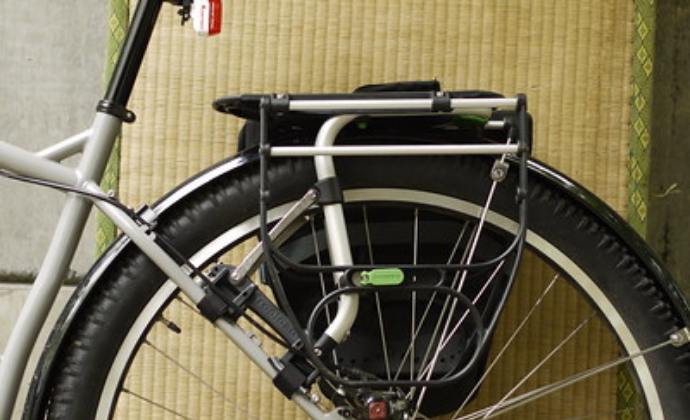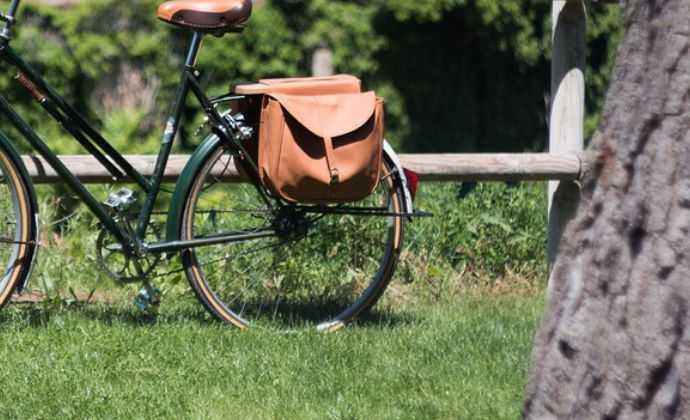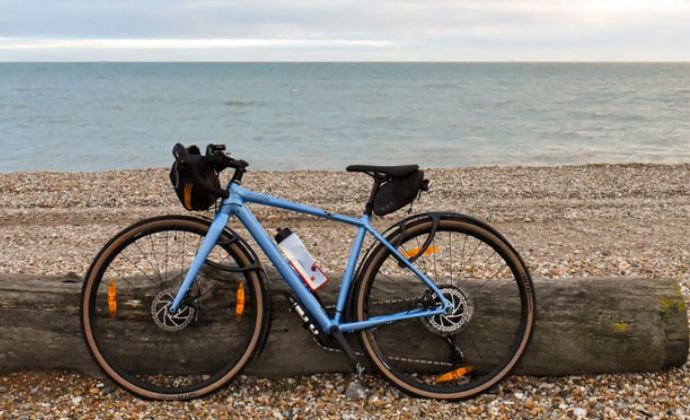After working in a bike shop for many years, I was often asked most weeks: Can you put panniers on a road bike? This is an excellent question, and it’s challenging to answer with a short yes or no.
In this article, we’re going to run through if you can use a pannier rack on your road bike. We will also talk about the different types of pannier racks and some special equipment you might need to fit them.
What are Panniers?

A pannier rack is a luggage carrying tool for your bike. Many cyclists refer to them as bike racks. A good way of thinking about it is backpacks for your bike.
They go on the front or rear and are designed to take the weight of anything you need to carry. Typically you will see a pannier rack on touring bikes traveling miles across countries, full of sleeping gear and camping equipment, or you might even see them on commuters with total clothing changes for the office.
They come in many different shapes and sizes. Typically, they are small rectangular bags that sit on the side and are made of waterproof materials.
Can You Attach Panniers to a Road Bike?

It depends on the bike. There are specific bikes that can be very easily, and there are other bikes that are not able to quite so easily. The first thing you have to find out is if your bike has rear rack eyelets.
Rear rack eyelets are little holes on the frame’s rear near the rear axle, and these are required to attach the pannier rack to the back.
If you have rear rack eyelets, you will have some extra bolt mounts just behind the seat post as well, and these are where you attach the pannier rack to the front.
What if my bike doesn’t have rear rack eyelets?

Some touring bikes and road bikes don’t have a pannier mounting system. If your bike doesn’t have eyelets, do not worry. There are solutions, you can get special adaptors that you can connect to your bike, which is a straightforward job to fit.
You will also find that many pannier systems are made to connect to a bike that doesn’t have eyelets. They typically attach to your rear axle, and then you have special clips to attach to the frame’s rear triangle above the rear wheel.
Putting panniers or rear racks will require cushioned metal loop straps and a special kit to make them fit on bikes without eyelets.
If you are using a carbon fiber road bike and planning on using a pannier mount that attaches and clamps onto the frame, you will have to be extremely cautious and make sure they don’t damage the carbon bike’s frame.
It’s worth looking at specialist racks that work with carbon bikes, such as Tailfin. Mounting panniers or rear racks on carbon seat stays can be a dangerous approach with caution.
We Think You’ll Like: The 10 Best Bikes for College Students
How do standard panniers attach to a typical road bike?

Fitting standard panniers is very simple, and anyone could do it. You will require an Allen key set.
Step one: Organise
Take the rear rack you have purchased out of the box, separate the rack from the bolts, and lie it out on the floor next to each other. Have your road bike in a safe working space.
Step two: Attach the rear
Now you are going to want to screw the bottom of the rear rack onto the eyelets next to the rear axle. Make sure these are nice and tight, and if the instructions state a torque setting, we recommend you go to that.
Step three: Front Attachments and adjustments
Attach the front struts of the pannier rack to the bolts on the rear of the road bike seat tube and tighten up. Typically many panniers will also be adjustable at this point, so I would highly recommend getting a sprint level on the panniers and adjusting it until it is flat.
Step four: Checks
Now you need to check that the rack is on solid and doesn’t move about. If it does move, you need to make sure everything is tight. Remember, you will be adding a lot of weight to these, and you need to know they are capable of carrying them.
Step five: Add the bags to your road bike
Now the best bit, get everything packed and attach the bags to the side or if you have a top bag on the top. All bags attach differently depending on the brand, but the majority just clip on to the side. Now your road bike has a bike rack and you’re ready for bike touring.
We Think You’ll Like: Best Road Bikes Under 1000
Even Weight Distribution on Pannier Racks

When adding a lot of kit onto panniers, it’s vital to make sure that the weight is evenly distributed. When you put too much weight on one side, it makes the bike less controllable when going around a corner.
In my opinion, the best thing to do is to either put all your gear on the top and stack it a little taller or split it on either side. It will feel much better when riding your bike, and you won’t be fighting it on corners.
Do you leave panniers on your bike when you stop?

I personally wouldn’t recommend leaving them on the bike when you stop and are either locking up or at a bike park. They are effortless to take off and steal. If you have a safe place, leaving them on wouldn’t be an issue.
Panniers are typically made of rugged material, and they are made to be outdoor and in challenging conditions, so leaving them on all the time shouldn’t damage them.
Related Article: How to Convert a Road Bike to a Gravel Bike
What are the other options?
Not all road bikes can have panniers on, and maybe you don’t like the look of panniers, but what are the other options.
Saddlebags

Saddlebags are bikepacking gear, and they attach to the seat of the bike and stick out on the rear. They are not as stable as a pannier and can’t hold as much, but it is perfect for a change of clothes or some sleeping equipment.
Handlebar Roll bags

Roll bags sit on the handlebars at the front of road bikes. They don’t have a huge capacity because of the drop handlebars, but you will get a change of clothes in one but not anywhere near as much as the pannier system.
Frame Bags

Frame bags sit in the middle of the bike in the large triangle of the frame. They only have a small capacity, and you will not want to overload these. They also can take up the space where you need bottles.
Can anything give the capacity of panniers?
If you want the capacity of panniers, then you will need to take all these above to get close. Panniers carry so much and are such an excellent tool for bicycle touring or commuting.
How Much Can Panniers Carry?

Panniers are made to take the weight, but this differs depending on which kind of panniers you get. Some can hold only 25kg max, and others can carry 50kg max. It’s worth looking into before buying so you don’t end up overloading them.
Other Types of Panniers

There are many types of bike racks on the market. You get pannier racks that attach to the front of the bike on top of the front wheel, and these are commonly seen on a specialist touring bike.
Then you have pannier racks that bolt straight to the seat post, which are ok but tend to be prone to swinging side to side with the seat post as a lever. I wouldn’t recommend a seat post-mounted rack on all bikes.
Conclusion
Panniers are an excellent tool for long-distance cycling and touring. They give the bike the ability to carry so much extra stuff, and that can turn your bike rides into huge adventures. Road bikes with rear panniers are often referred to as touring bike.
When mounting racks, make sure you have done it correctly and followed the manufacturer’s instructions, and don’t forget to remove your bags when you can’t see the bike, or it’s locked up.












